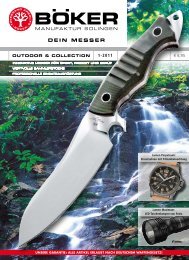Boker Barbers Corner | BUSA Edition 2017 / 2018
You also want an ePaper? Increase the reach of your titles
YUMPU automatically turns print PDFs into web optimized ePapers that Google loves.
48<br />
BÖKER MANUFAKTUR SOLINGEN<br />
SHARPENING OF STRAIGHT RAZORS<br />
If you love your razor, you will want<br />
to be able to care for it yourself.<br />
This also includes sharpening it<br />
on the whetstone. The edge<br />
slowly becomes rounded due<br />
to regular stropping. This is<br />
intentional up to a certain point.<br />
However, at some point the angle<br />
of the edge becomes too steep<br />
and has to be ground flat again<br />
using a whetstone. Grinding also<br />
becomes necessary if the edge<br />
was damaged due to unintentional<br />
bumping, falls, or rust due to<br />
improper storage.<br />
We have compiled a small guideline<br />
for stones and sharpening. A<br />
grinding material or abrasive<br />
is defined by two parameters.<br />
One parameter is grit, the other<br />
binding. The grit states how fine<br />
or coarse the structure of the<br />
stone is. The coarser the grit, the<br />
more steel the stone removes and<br />
the faster it works. In synthetic<br />
stones, the grit is determined in<br />
production by using corresponding<br />
sieves. In natural stones, the grit<br />
can only be stated approximately.<br />
The standard commercial measure<br />
is JIS (Japanese Industrial<br />
Standard). The European FEPA<br />
standard is almost exclusively<br />
used in industrial applications.<br />
The stones used for straight razors<br />
should be fine.<br />
Opinions vary on what exact<br />
grit should be used for synthetic<br />
stones for the final grind. For<br />
straight razors, we only use and<br />
deal with proven traditional natural<br />
stones whose grit corresponds to<br />
4000 to 10000 JIS.<br />
\<br />
The binding states how strongly<br />
the grit, the actual grinding hard<br />
particles, are bound to each other.<br />
The grinding particles blunt over<br />
time and break out of the stone.<br />
This allows the stone to remain<br />
sharp over time. The softer<br />
the binding, the faster the stone<br />
works and the faster it wears.<br />
There are no standard industry<br />
and retail indicators for binding.<br />
ATTENTION! Straight razors are<br />
never ground on dry stones. The<br />
natural stone "Belgian Brocken"<br />
(Fr.: Coticule) is used with water.<br />
Its very soft binding creates a<br />
fine grinding mud over which the<br />
blade glides. American Arkansas<br />
stones, also natural stones, are<br />
used exclusively with a special<br />
grinding oil. These stones have<br />
a very hard binding and basically<br />
don’t wear at all.<br />
Similar to stropping, during<br />
grinding, first carefully place the<br />
back and then the edge on the<br />
stone. However, in contrast to<br />
stropping, do not pull away from<br />
the edge but rather push into the<br />
edge. To do so, place three or<br />
four fingers on the back of the<br />
blade and push the razor across<br />
the stone with light pressure in<br />
the direction of the edge. If the<br />
blade is positioned correctly, the<br />
water on the Belgian Brocken<br />
or the oil on the Arkansas stone<br />
forms a small wave in front of the<br />
edge. If the back is decorated<br />
with gilding, etching, or an<br />
engraving, you should cover it<br />
with thin insulating tape to avoid<br />
grinding off the decoration.<br />
Once the straight razor has been<br />
sharpened sufficiently, strop it<br />
on a belt treated with paste, and<br />
finally on an untreated strop.


















